Statistics: Decision Making, Hotel Modeling, Regression Analysis
VerifiedAdded on 2021/06/17
|29
|2341
|5
Homework Assignment
AI Summary
This assignment presents a detailed analysis of statistical concepts through various problem-solving scenarios. It begins with an exploration of decision-making processes, including the use of conditional profit matrices, optimistic and pessimistic strategies, Laplace criterion, and EMV (Expected Monetary Value) analysis to determine optimal choices. The assignment then delves into cost-effective modeling for a hotel, simulating room bookings, analyzing overbooking scenarios, and providing suggestions to the hotel manager. Furthermore, it investigates regression models to assess the relationship between car prices and factors like mileage and age, including the evaluation of correlation between variables. Finally, the assignment concludes with model setup and solver solutions using MS Excel to determine optimal profit levels for different products.
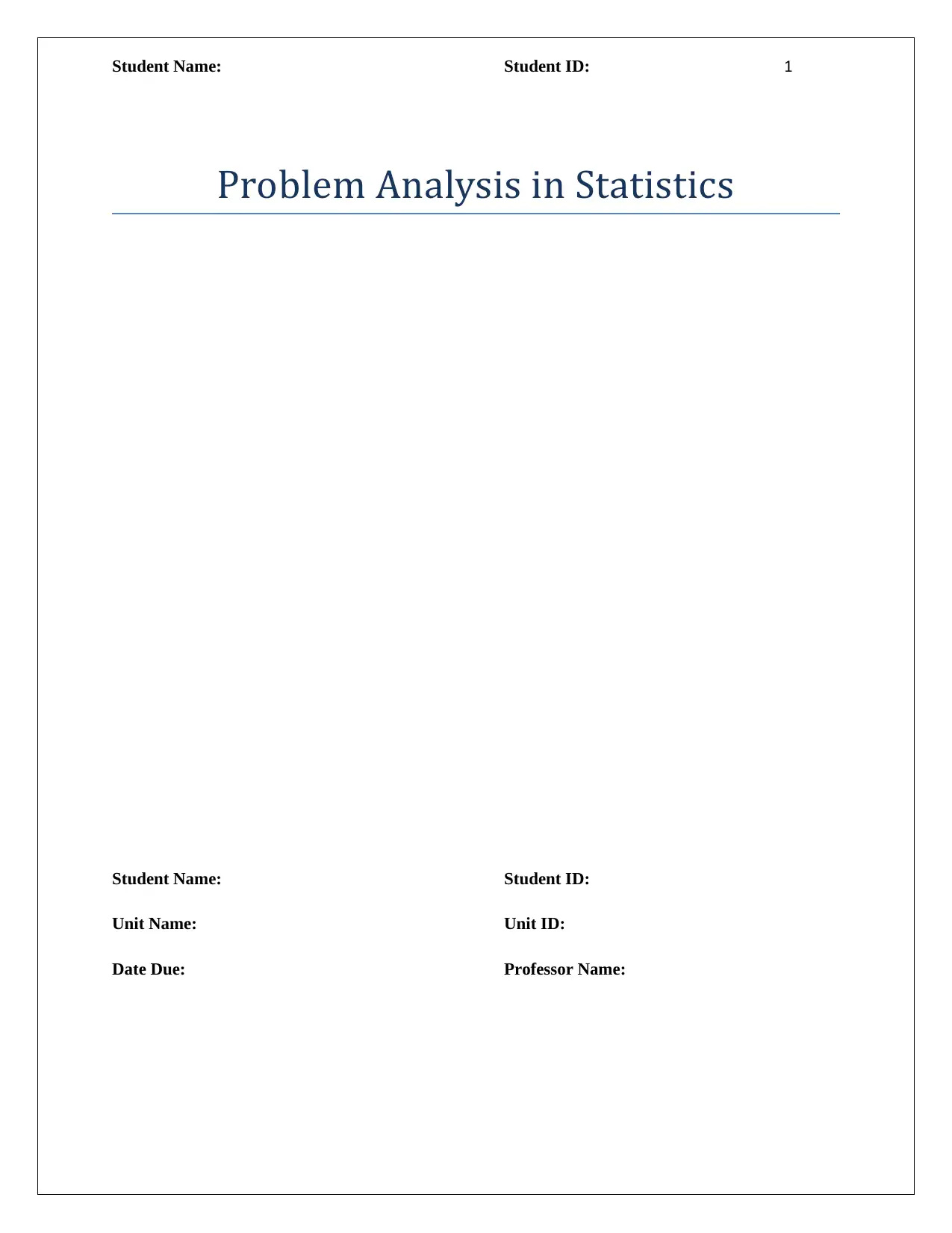
Student Name: Student ID: 1
Problem Analysis in Statistics
Student Name: Student ID:
Unit Name: Unit ID:
Date Due: Professor Name:
Problem Analysis in Statistics
Student Name: Student ID:
Unit Name: Unit ID:
Date Due: Professor Name:
Paraphrase This Document
Need a fresh take? Get an instant paraphrase of this document with our AI Paraphraser
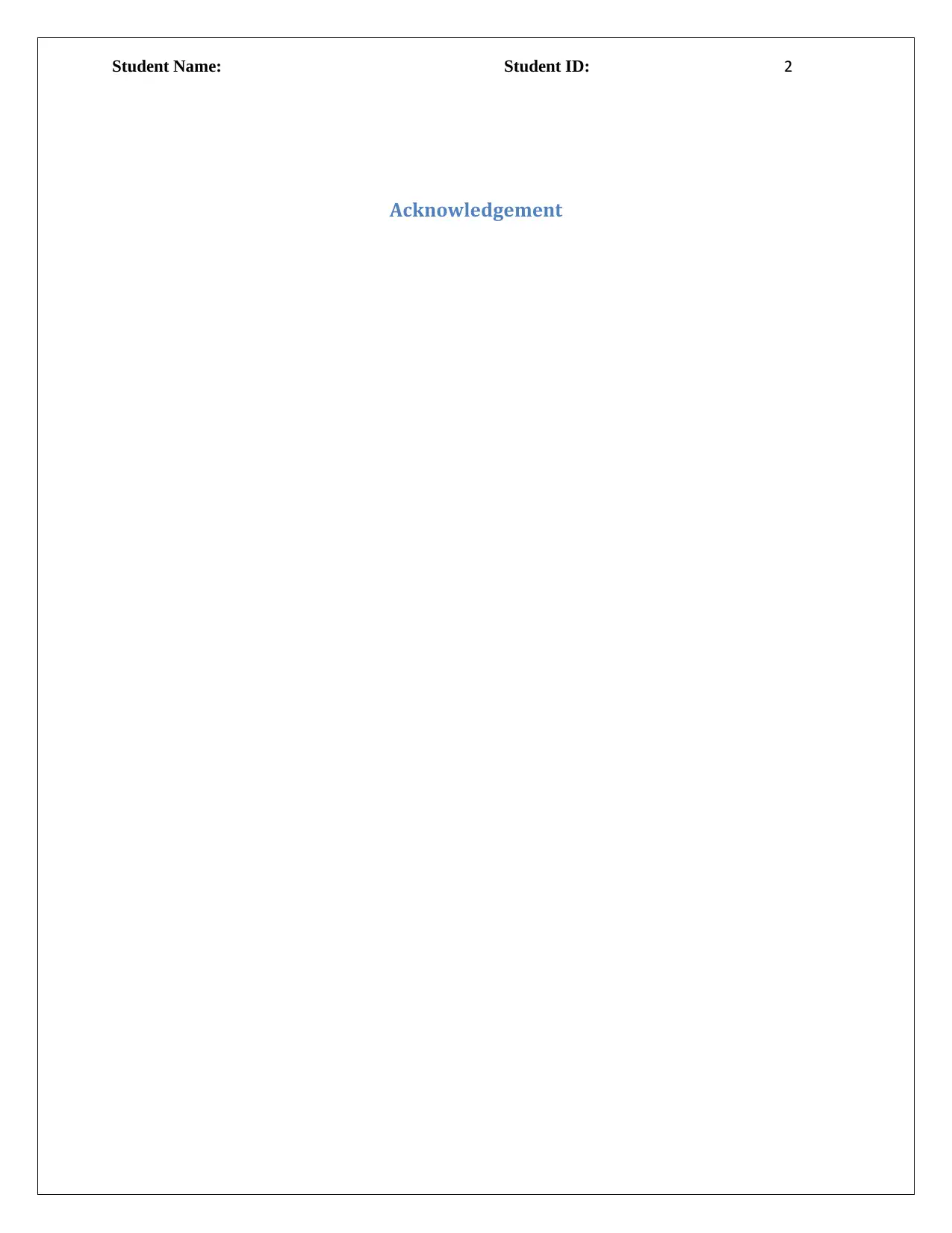
Student Name: Student ID: 2
Acknowledgement
Acknowledgement
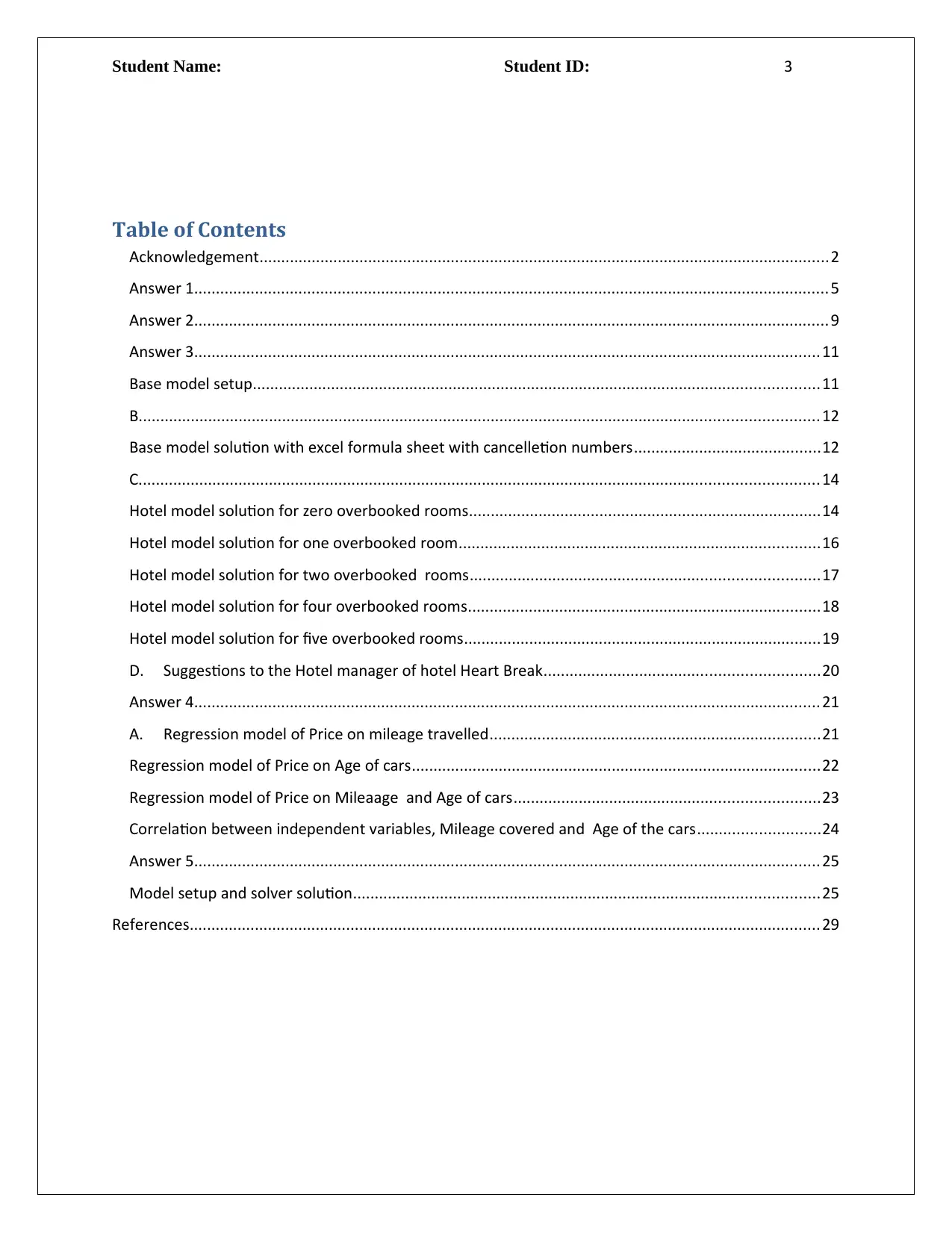
Student Name: Student ID: 3
Table of Contents
Acknowledgement...................................................................................................................................2
Answer 1..................................................................................................................................................5
Answer 2..................................................................................................................................................9
Answer 3................................................................................................................................................11
Base model setup..................................................................................................................................11
B............................................................................................................................................................12
Base model solution with excel formula sheet with cancelletion numbers...........................................12
C............................................................................................................................................................14
Hotel model solution for zero overbooked rooms.................................................................................14
Hotel model solution for one overbooked room...................................................................................16
Hotel model solution for two overbooked rooms................................................................................17
Hotel model solution for four overbooked rooms.................................................................................18
Hotel model solution for five overbooked rooms..................................................................................19
D. Suggestions to the Hotel manager of hotel Heart Break...............................................................20
Answer 4................................................................................................................................................21
A. Regression model of Price on mileage travelled............................................................................21
Regression model of Price on Age of cars..............................................................................................22
Regression model of Price on Mileaage and Age of cars......................................................................23
Correlation between independent variables, Mileage covered and Age of the cars............................24
Answer 5................................................................................................................................................25
Model setup and solver solution...........................................................................................................25
References.................................................................................................................................................29
Table of Contents
Acknowledgement...................................................................................................................................2
Answer 1..................................................................................................................................................5
Answer 2..................................................................................................................................................9
Answer 3................................................................................................................................................11
Base model setup..................................................................................................................................11
B............................................................................................................................................................12
Base model solution with excel formula sheet with cancelletion numbers...........................................12
C............................................................................................................................................................14
Hotel model solution for zero overbooked rooms.................................................................................14
Hotel model solution for one overbooked room...................................................................................16
Hotel model solution for two overbooked rooms................................................................................17
Hotel model solution for four overbooked rooms.................................................................................18
Hotel model solution for five overbooked rooms..................................................................................19
D. Suggestions to the Hotel manager of hotel Heart Break...............................................................20
Answer 4................................................................................................................................................21
A. Regression model of Price on mileage travelled............................................................................21
Regression model of Price on Age of cars..............................................................................................22
Regression model of Price on Mileaage and Age of cars......................................................................23
Correlation between independent variables, Mileage covered and Age of the cars............................24
Answer 5................................................................................................................................................25
Model setup and solver solution...........................................................................................................25
References.................................................................................................................................................29
⊘ This is a preview!⊘
Do you want full access?
Subscribe today to unlock all pages.

Trusted by 1+ million students worldwide
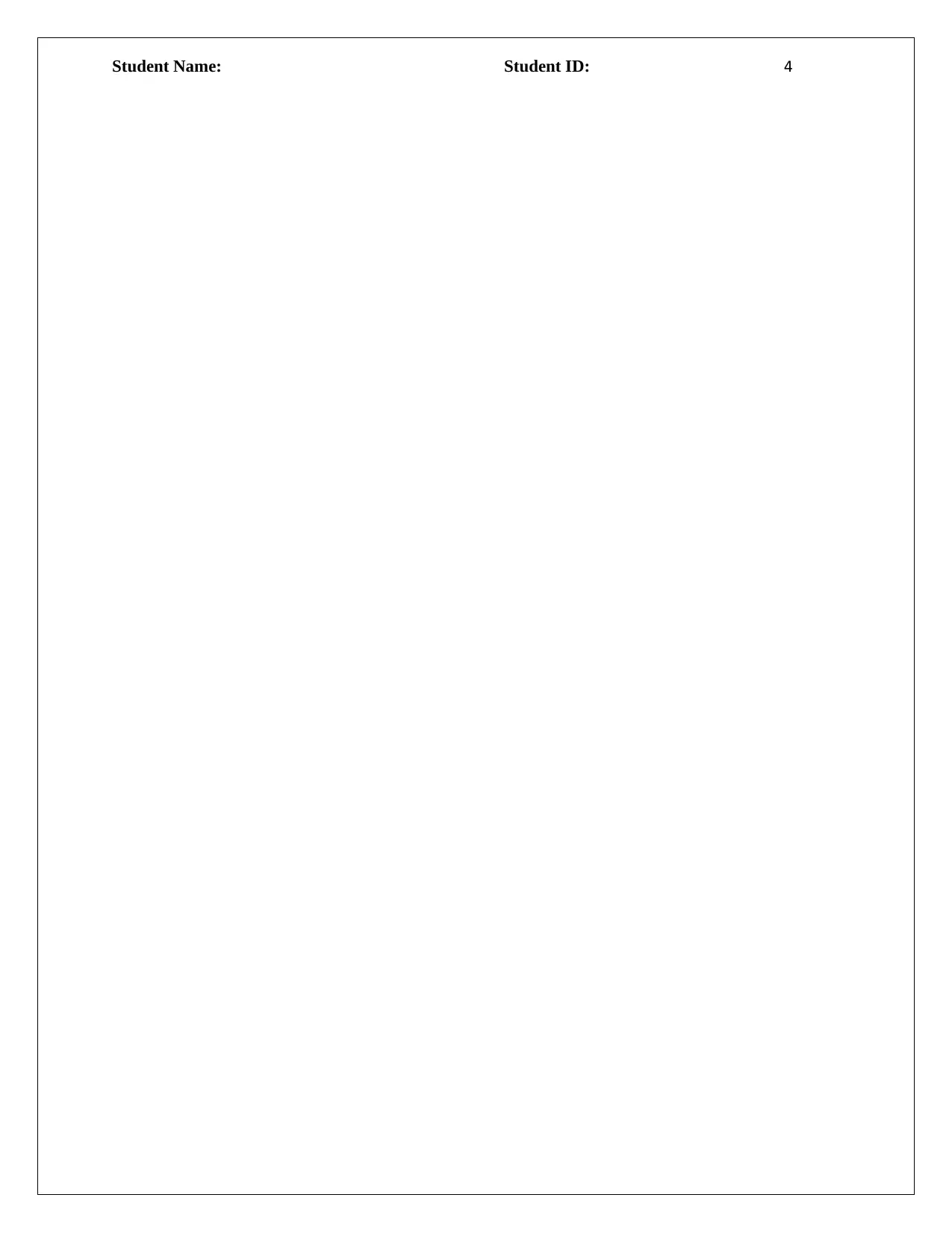
Student Name: Student ID: 4
Paraphrase This Document
Need a fresh take? Get an instant paraphrase of this document with our AI Paraphraser
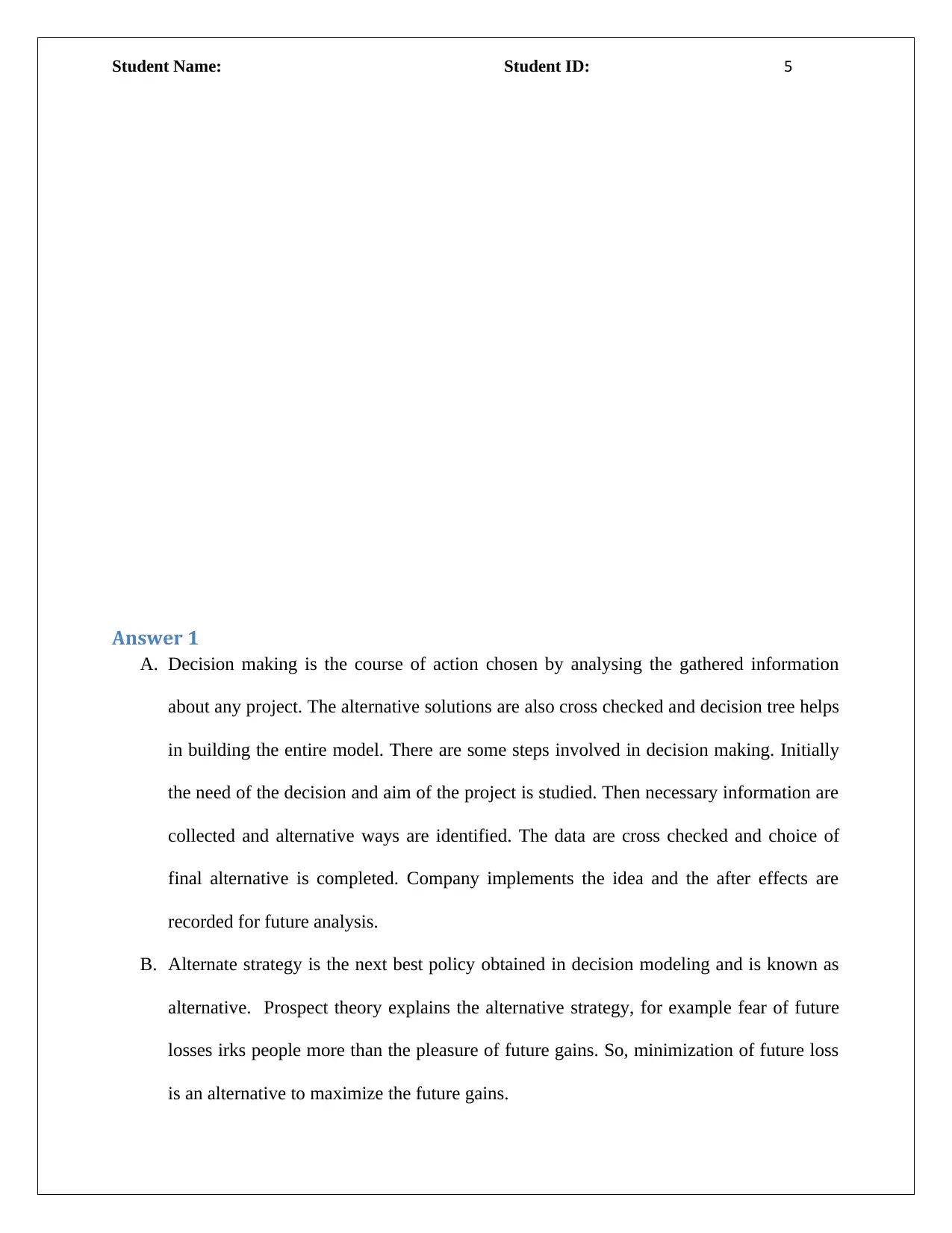
Student Name: Student ID: 5
Answer 1
A. Decision making is the course of action chosen by analysing the gathered information
about any project. The alternative solutions are also cross checked and decision tree helps
in building the entire model. There are some steps involved in decision making. Initially
the need of the decision and aim of the project is studied. Then necessary information are
collected and alternative ways are identified. The data are cross checked and choice of
final alternative is completed. Company implements the idea and the after effects are
recorded for future analysis.
B. Alternate strategy is the next best policy obtained in decision modeling and is known as
alternative. Prospect theory explains the alternative strategy, for example fear of future
losses irks people more than the pleasure of future gains. So, minimization of future loss
is an alternative to maximize the future gains.
Answer 1
A. Decision making is the course of action chosen by analysing the gathered information
about any project. The alternative solutions are also cross checked and decision tree helps
in building the entire model. There are some steps involved in decision making. Initially
the need of the decision and aim of the project is studied. Then necessary information are
collected and alternative ways are identified. The data are cross checked and choice of
final alternative is completed. Company implements the idea and the after effects are
recorded for future analysis.
B. Alternate strategy is the next best policy obtained in decision modeling and is known as
alternative. Prospect theory explains the alternative strategy, for example fear of future
losses irks people more than the pleasure of future gains. So, minimization of future loss
is an alternative to maximize the future gains.
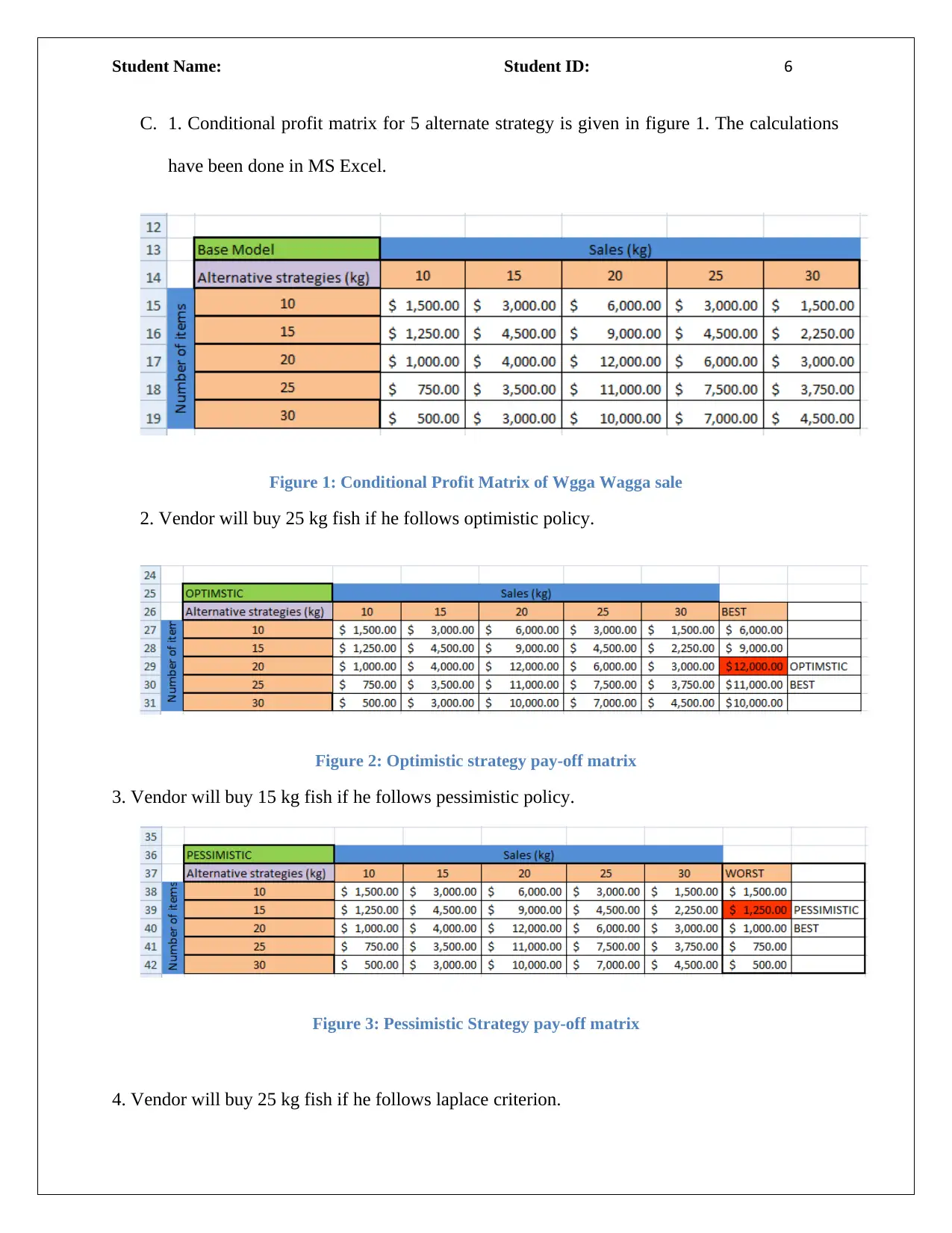
Student Name: Student ID: 6
C. 1. Conditional profit matrix for 5 alternate strategy is given in figure 1. The calculations
have been done in MS Excel.
Figure 1: Conditional Profit Matrix of Wgga Wagga sale
2. Vendor will buy 25 kg fish if he follows optimistic policy.
Figure 2: Optimistic strategy pay-off matrix
3. Vendor will buy 15 kg fish if he follows pessimistic policy.
Figure 3: Pessimistic Strategy pay-off matrix
4. Vendor will buy 25 kg fish if he follows laplace criterion.
C. 1. Conditional profit matrix for 5 alternate strategy is given in figure 1. The calculations
have been done in MS Excel.
Figure 1: Conditional Profit Matrix of Wgga Wagga sale
2. Vendor will buy 25 kg fish if he follows optimistic policy.
Figure 2: Optimistic strategy pay-off matrix
3. Vendor will buy 15 kg fish if he follows pessimistic policy.
Figure 3: Pessimistic Strategy pay-off matrix
4. Vendor will buy 25 kg fish if he follows laplace criterion.
⊘ This is a preview!⊘
Do you want full access?
Subscribe today to unlock all pages.

Trusted by 1+ million students worldwide
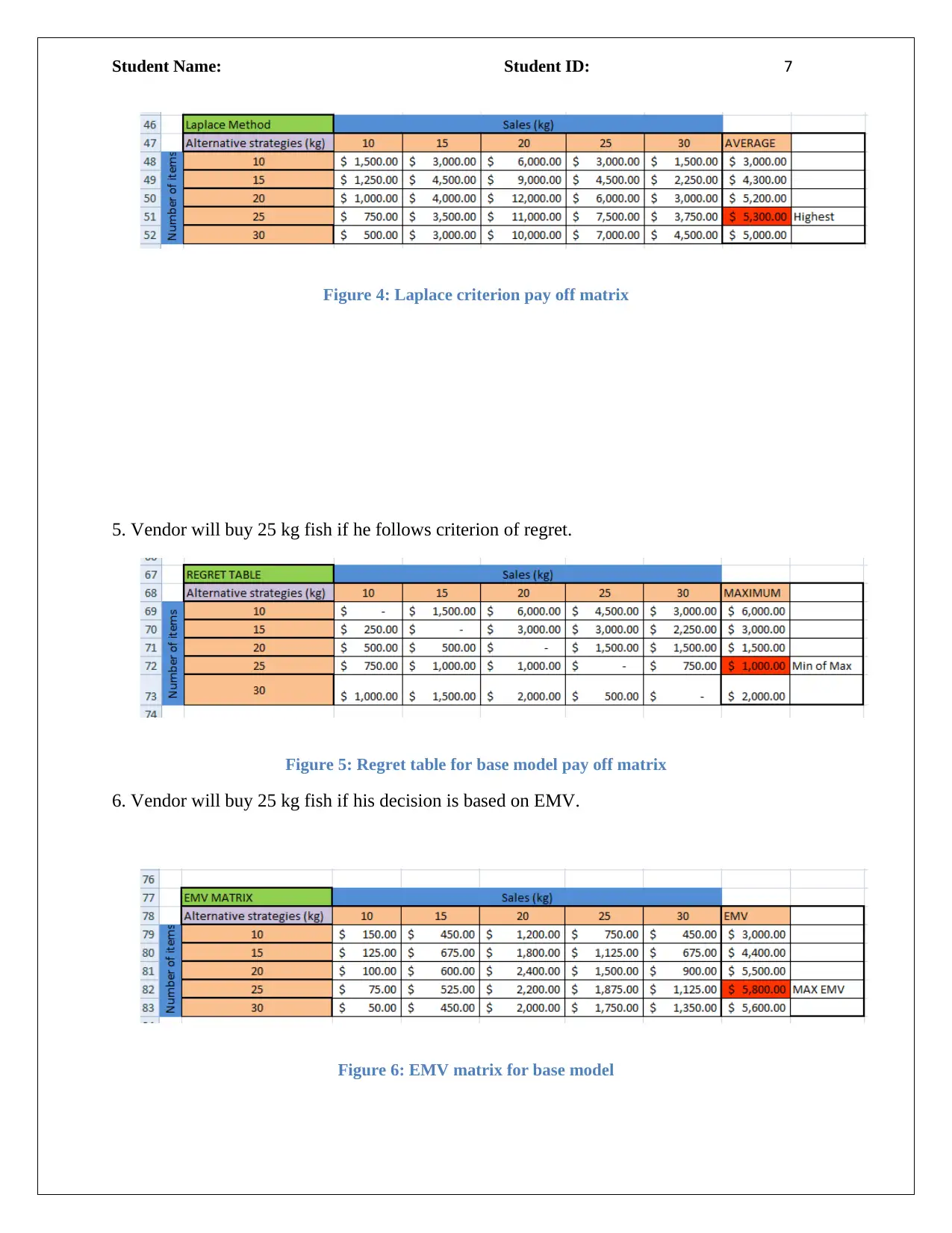
Student Name: Student ID: 7
Figure 4: Laplace criterion pay off matrix
5. Vendor will buy 25 kg fish if he follows criterion of regret.
Figure 5: Regret table for base model pay off matrix
6. Vendor will buy 25 kg fish if his decision is based on EMV.
Figure 6: EMV matrix for base model
Figure 4: Laplace criterion pay off matrix
5. Vendor will buy 25 kg fish if he follows criterion of regret.
Figure 5: Regret table for base model pay off matrix
6. Vendor will buy 25 kg fish if his decision is based on EMV.
Figure 6: EMV matrix for base model
Paraphrase This Document
Need a fresh take? Get an instant paraphrase of this document with our AI Paraphraser
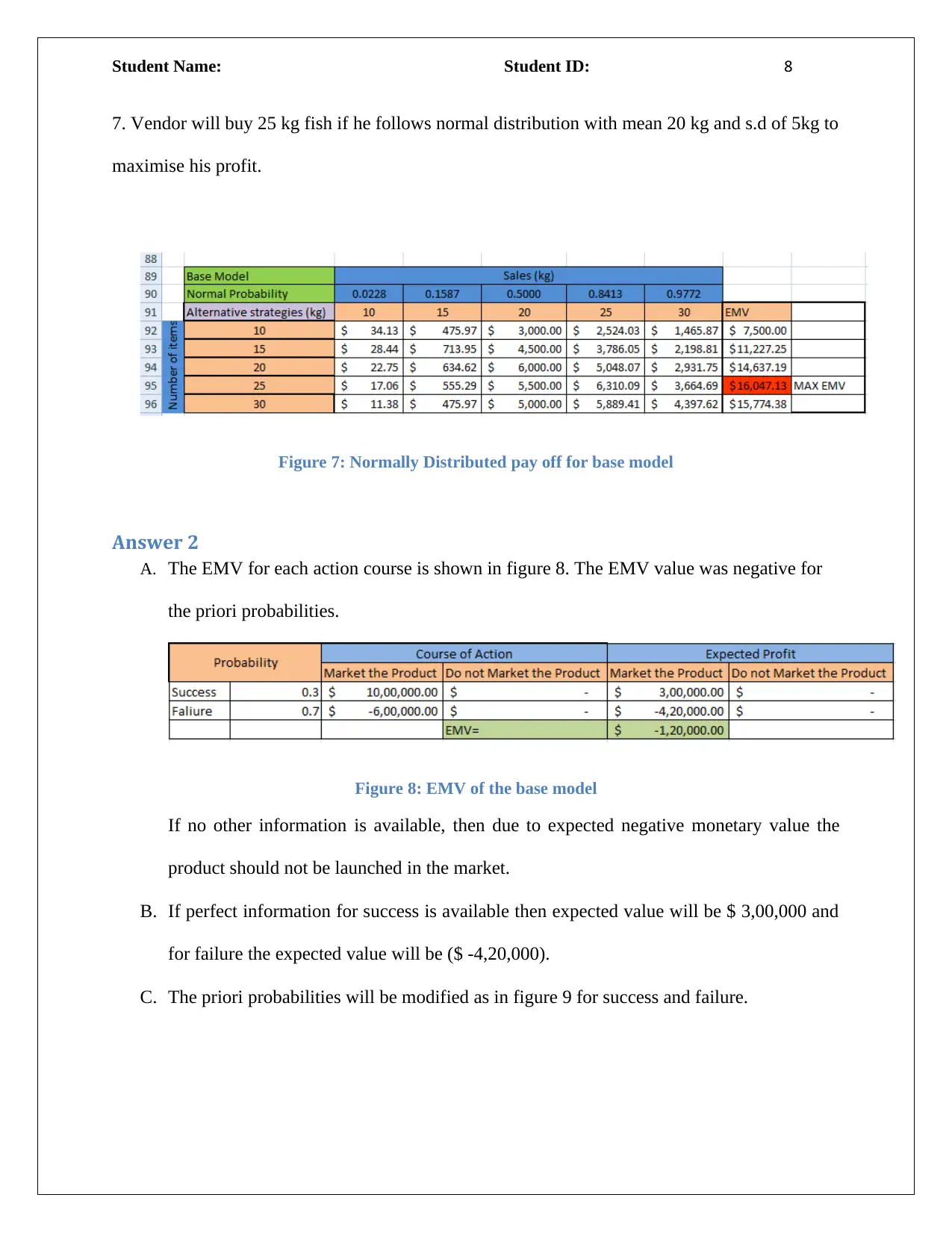
Student Name: Student ID: 8
7. Vendor will buy 25 kg fish if he follows normal distribution with mean 20 kg and s.d of 5kg to
maximise his profit.
Figure 7: Normally Distributed pay off for base model
Answer 2
A. The EMV for each action course is shown in figure 8. The EMV value was negative for
the priori probabilities.
Figure 8: EMV of the base model
If no other information is available, then due to expected negative monetary value the
product should not be launched in the market.
B. If perfect information for success is available then expected value will be $ 3,00,000 and
for failure the expected value will be ($ -4,20,000).
C. The priori probabilities will be modified as in figure 9 for success and failure.
7. Vendor will buy 25 kg fish if he follows normal distribution with mean 20 kg and s.d of 5kg to
maximise his profit.
Figure 7: Normally Distributed pay off for base model
Answer 2
A. The EMV for each action course is shown in figure 8. The EMV value was negative for
the priori probabilities.
Figure 8: EMV of the base model
If no other information is available, then due to expected negative monetary value the
product should not be launched in the market.
B. If perfect information for success is available then expected value will be $ 3,00,000 and
for failure the expected value will be ($ -4,20,000).
C. The priori probabilities will be modified as in figure 9 for success and failure.
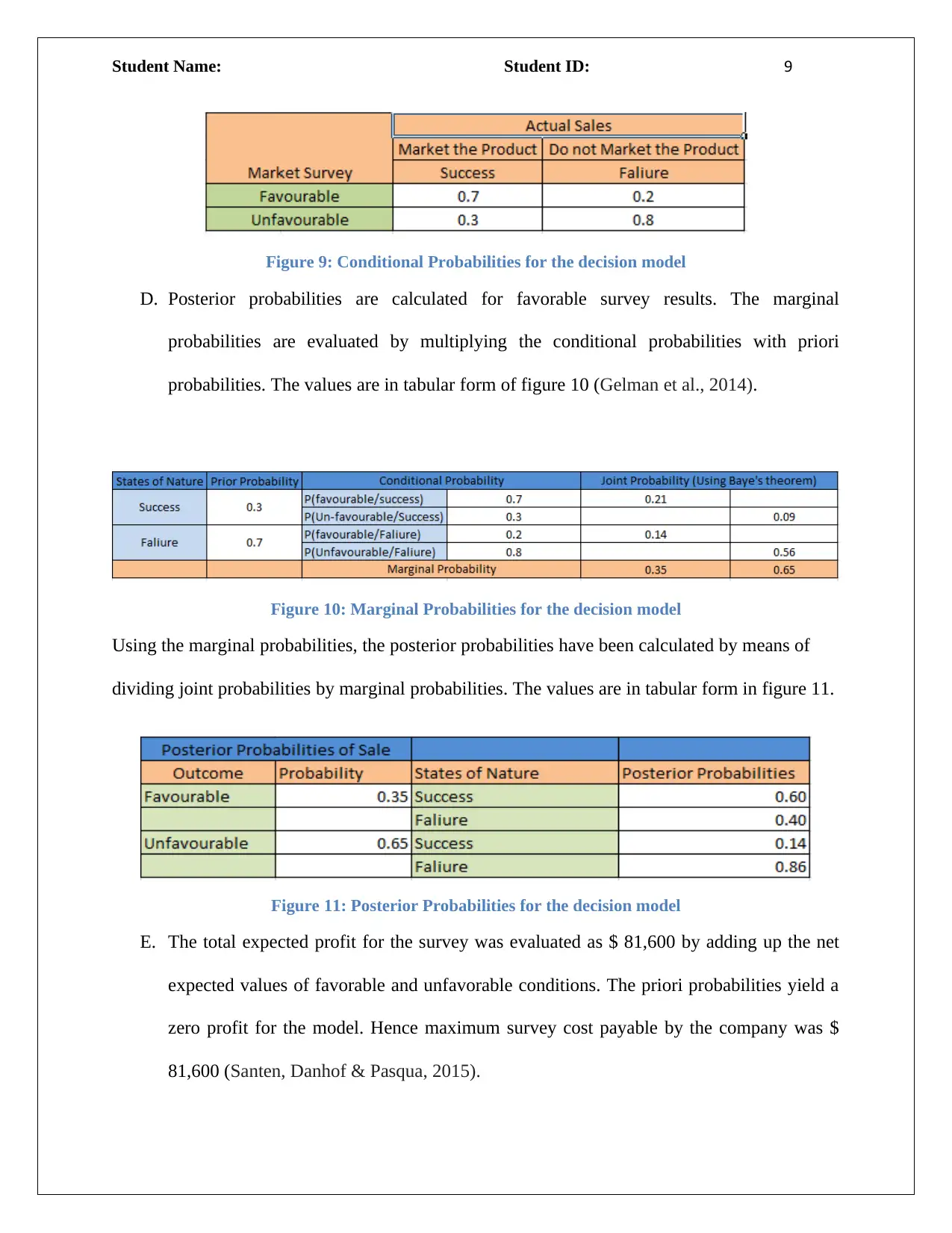
Student Name: Student ID: 9
Figure 9: Conditional Probabilities for the decision model
D. Posterior probabilities are calculated for favorable survey results. The marginal
probabilities are evaluated by multiplying the conditional probabilities with priori
probabilities. The values are in tabular form of figure 10 (Gelman et al., 2014).
Figure 10: Marginal Probabilities for the decision model
Using the marginal probabilities, the posterior probabilities have been calculated by means of
dividing joint probabilities by marginal probabilities. The values are in tabular form in figure 11.
Figure 11: Posterior Probabilities for the decision model
E. The total expected profit for the survey was evaluated as $ 81,600 by adding up the net
expected values of favorable and unfavorable conditions. The priori probabilities yield a
zero profit for the model. Hence maximum survey cost payable by the company was $
81,600 (Santen, Danhof & Pasqua, 2015).
Figure 9: Conditional Probabilities for the decision model
D. Posterior probabilities are calculated for favorable survey results. The marginal
probabilities are evaluated by multiplying the conditional probabilities with priori
probabilities. The values are in tabular form of figure 10 (Gelman et al., 2014).
Figure 10: Marginal Probabilities for the decision model
Using the marginal probabilities, the posterior probabilities have been calculated by means of
dividing joint probabilities by marginal probabilities. The values are in tabular form in figure 11.
Figure 11: Posterior Probabilities for the decision model
E. The total expected profit for the survey was evaluated as $ 81,600 by adding up the net
expected values of favorable and unfavorable conditions. The priori probabilities yield a
zero profit for the model. Hence maximum survey cost payable by the company was $
81,600 (Santen, Danhof & Pasqua, 2015).
⊘ This is a preview!⊘
Do you want full access?
Subscribe today to unlock all pages.

Trusted by 1+ million students worldwide
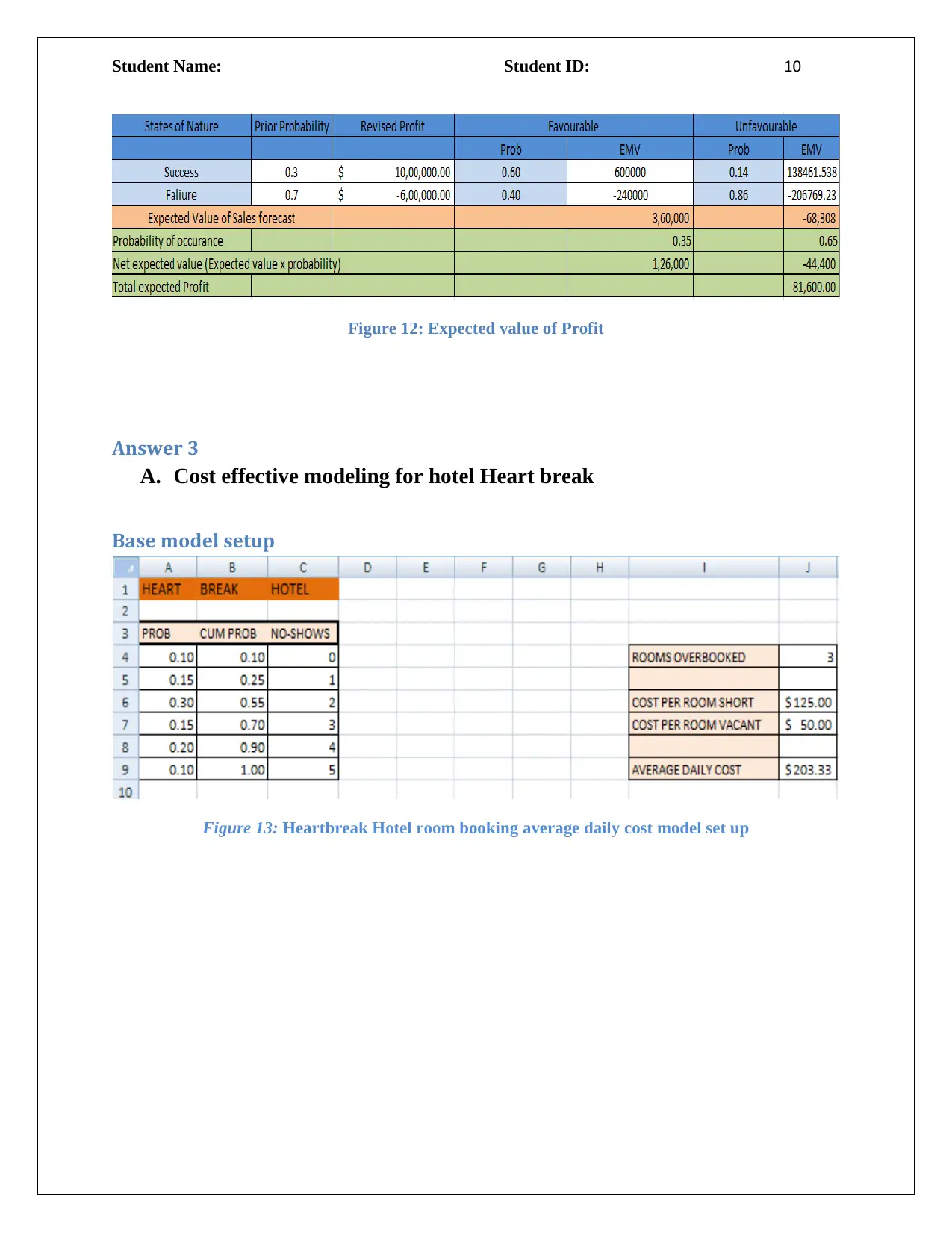
Student Name: Student ID: 10
Figure 12: Expected value of Profit
Answer 3
A. Cost effective modeling for hotel Heart break
Base model setup
Figure 13: Heartbreak Hotel room booking average daily cost model set up
Figure 12: Expected value of Profit
Answer 3
A. Cost effective modeling for hotel Heart break
Base model setup
Figure 13: Heartbreak Hotel room booking average daily cost model set up
Paraphrase This Document
Need a fresh take? Get an instant paraphrase of this document with our AI Paraphraser
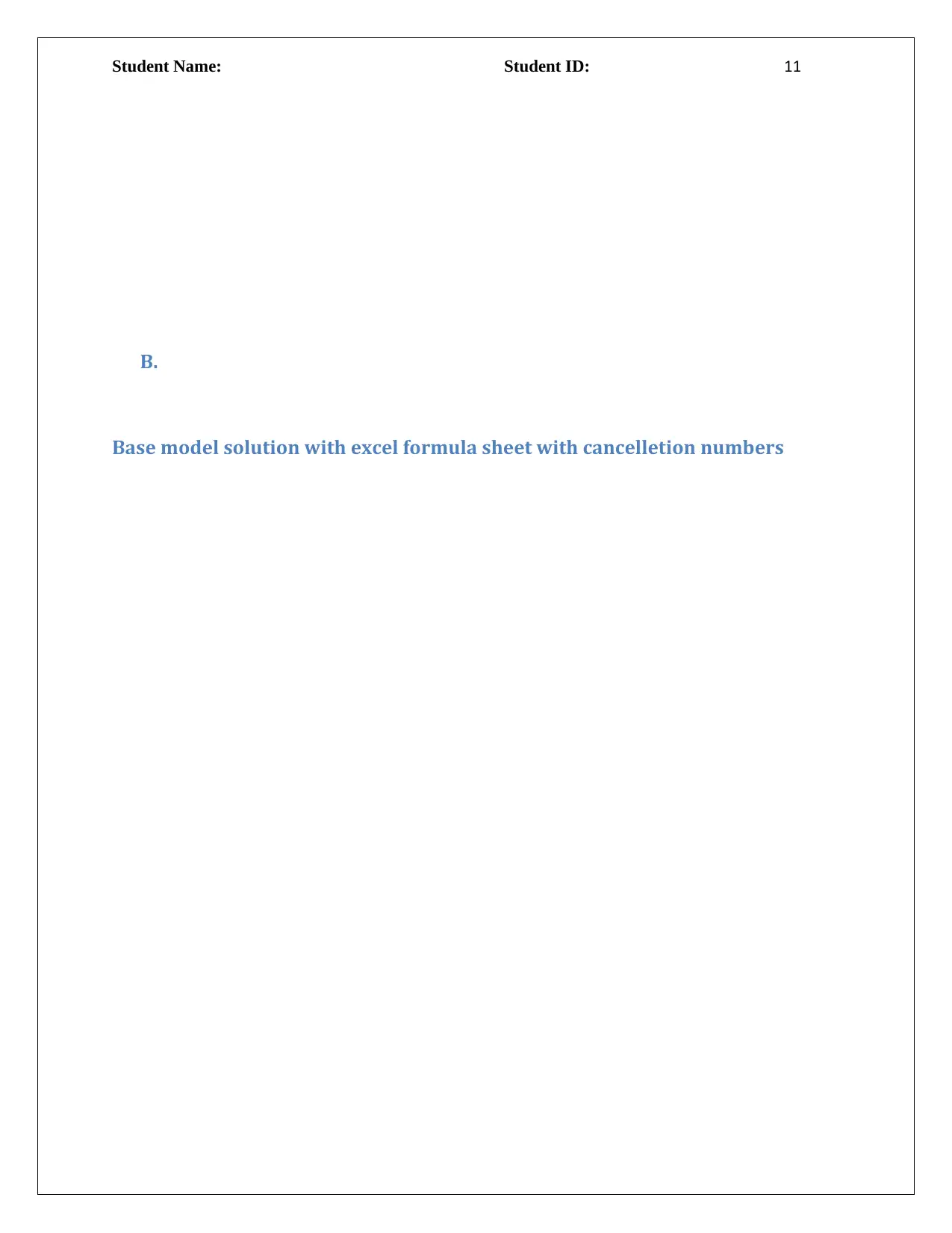
Student Name: Student ID: 11
B.
Base model solution with excel formula sheet with cancelletion numbers
B.
Base model solution with excel formula sheet with cancelletion numbers
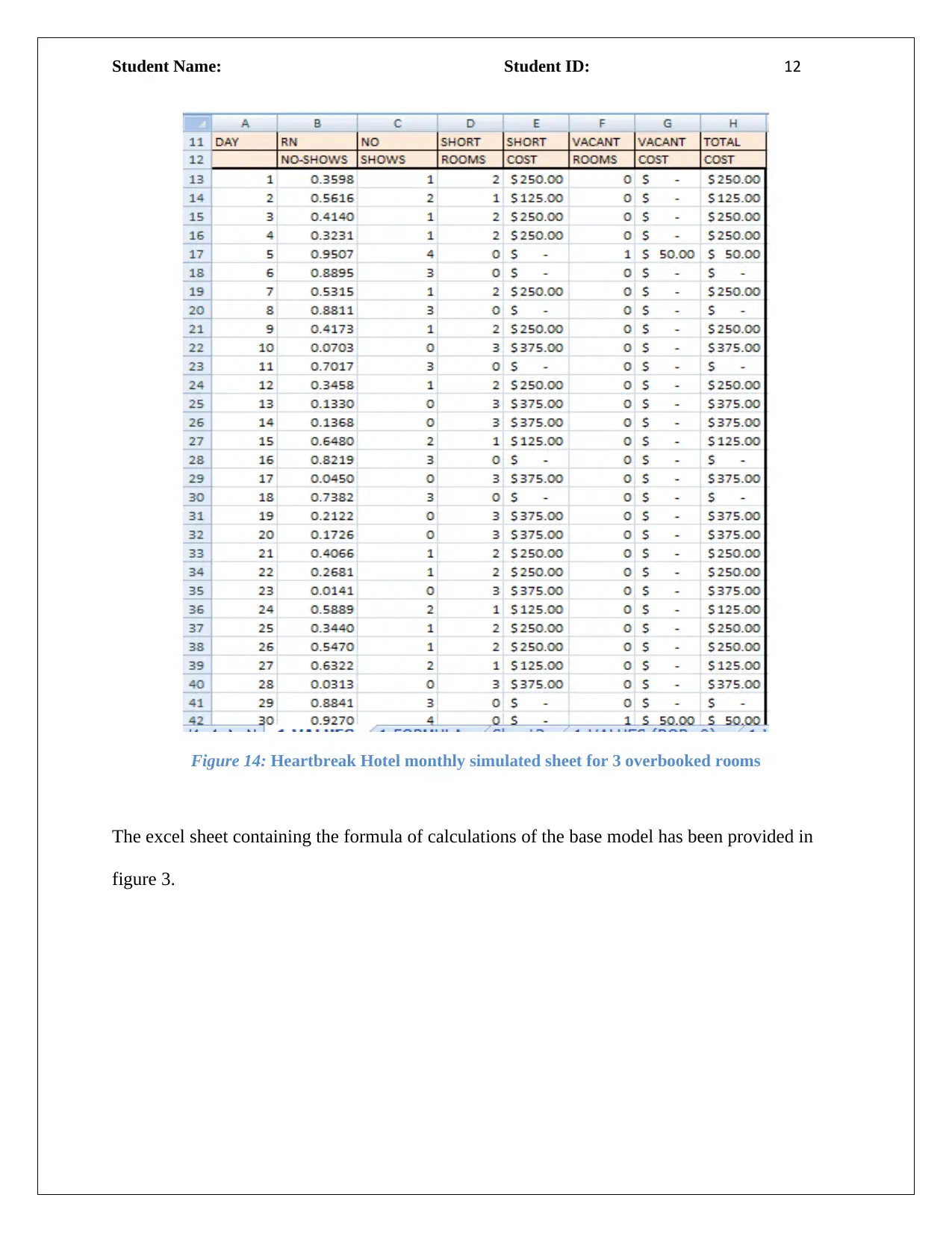
Student Name: Student ID: 12
Figure 14: Heartbreak Hotel monthly simulated sheet for 3 overbooked rooms
The excel sheet containing the formula of calculations of the base model has been provided in
figure 3.
Figure 14: Heartbreak Hotel monthly simulated sheet for 3 overbooked rooms
The excel sheet containing the formula of calculations of the base model has been provided in
figure 3.
⊘ This is a preview!⊘
Do you want full access?
Subscribe today to unlock all pages.

Trusted by 1+ million students worldwide
1 out of 29
Related Documents
Your All-in-One AI-Powered Toolkit for Academic Success.
+13062052269
info@desklib.com
Available 24*7 on WhatsApp / Email
![[object Object]](/_next/static/media/star-bottom.7253800d.svg)
Unlock your academic potential
Copyright © 2020–2025 A2Z Services. All Rights Reserved. Developed and managed by ZUCOL.




![Accounting Decision Support Tools Assessment Item 3 Solution [Date]](/_next/image/?url=https%3A%2F%2Fdesklib.com%2Fmedia%2Fimages%2Fwx%2F8b0579db5dc54829a8e805e0dcb6f432.jpg&w=256&q=75)
![Assignment: Accounting Decision Support Tools - [Date] - Finance](/_next/image/?url=https%3A%2F%2Fdesklib.com%2Fmedia%2Fimages%2Fga%2F85e3fe63d61d4af3a506409b3f137201.jpg&w=256&q=75)